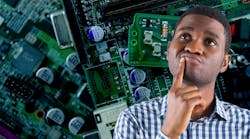How often do you think of the unintended consequences of the electronic product you are designing? Probably never. Well, maybe engineers should take a step back and brainstorm the potential outcomes, both positive and negative. We usually focus on the positive since we are designing with new technology to make products faster, lighter, more efficient, and less expensive with greater competitive features. Somehow we seem to naturally overlook the possible downsides of the new product or technology.
The good news is that new electronic technologies and products offer benefits that let us do things we could not do before. They make us more productive, give us vast amounts of good entertainment, provide conveniences, and expand our communications capabilities. Our smartphones give us all of these as an example. The internet and social media have had all sorts of positive outcomes.
The bad news is that new electronic technologies and products often produce negative outcomes we do not foresee. Often these unintended consequences are positive, but many times they are not. On top of that, unintended consequences are subtle and hard (if not impossible) to predict. E-mail is a good example. It is an excellent way to communicate, and almost everyone uses it. But who predicted spam, scams, and hacking? Not to mention, the overwhelming amount of time it takes to manage it all.
Anyway, several other examples occurred to me recently.
- Generally we design to make things simpler. Somewhere along the way we forgot the concept of making things “user friendly.” With microcontrollers, large cheap memory, and software at the heart of every product, it is easy and inexpensive to include lots of extra bells and whistles. These just tend to make things more complicated. Operating systems and applications programs keep getting bigger with more features, options, and capabilities making them ever more complicated to learn and use. Shouldn’t the goal be to make things easier?
- This is one that no one predicted. Who would have thought that the smartphone would be a major contributor to automotive deaths and injuries? Texting or talking on a smartphone is a significant distraction. Pedestrians suffer injuries or accidents by looking down at their phone and not paying attention to where they are. Even the big color LCD displays in the center of the dashboard on many new cars are a major distraction. Did anyone think this one through?
AI and robotics. Everyone says that artificial intelligence and robotics will take jobs away from humans. Others say that that is true, but new, better jobs will be created. Now California wants to tax AI and robots if they replace humans. Who would have thought?
Social Ills. Computers and the internet have created a form of laziness and dumbing down of the individual. Some have become more socially isolated. Social media has given rise to bullying and fake news. Are tweets good or bad? Voice monitoring and response systems like Alexa and Siri are great conveniences, but are they also a potential danger to privacy?
Tax reform. What will be the outcome of the new tax plan now being considered in Congress? Will companies really invest in more jobs or R&D if the tax rate comes down to 20%? What else could possibly go wrong?
Self-driving cars. Will self-driving vehicles really reduce traffic deaths? Or will it increase accidents, insurance rates, and car prices? Or what? This could be an accident waiting to happen.
Edward Tenner of Princeton University wrote a book about this a while back. Titled Why Things Bite Back: Technology and the Revenge of Unintended Consequences, the book offers up many great examples. Some good ones are:
- How computers were supposed to give us the paperless office, but instead we use more paper now because of the ease of making changes and additions.
- How the overuse of antibiotics has produced the development of increasingly resistant viruses.
- How technology requires more human effort, not less, to function properly. Tenner claims that it is a myth that technology is more reliable than humans and it does not free us from work. His view is that technology does solve some problems, but introduces other, more subtle (and even sinister) ones.
There are lots of other examples. Anyway, a good news/bad news analysis may be a good addition to any product development process. After all, what could possibly go wrong?

